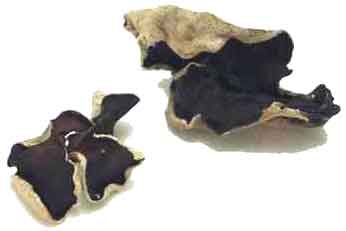 Subscribe to my feed for ingredients
Subscribe to my feed for ingredients  Add to My Yahoo
Add to My Yahoo 
© Copyright 1995-2023, Clay Irving <clay@panix.com>, Manhattan Beach, CA USA
 Subscribe to my feed for ingredients
Subscribe to my feed for ingredients  Add to My Yahoo
Add to My Yahoo
Wood Ear Characteristics
Wood ear mushrooms are also known as "black jelly", "tree ears", "cloud ears"1, "black fungus", "mouse ears", "kyet neywet" (in Burma), "mo-ei" or "wun yee" (in China), "kuping jamu" (in Indonesia), "kikurage" (in Japan), "kuping tikus" or "cendawan telinga kera" (in Malaysia), or "hed hunu" (in Thailand). These "mushrooms" are actually a type of fungus that grows rapidly on a variety of woods including mango and kapok.
Wood ear is mostly sold dry and is reconstituted in water for approximately 15 to 30 minutes before using. The wood ear swells many times its dried size. It is rinsed thoroughly, trimmed, and cut to the desired size.
It is prized in Chinese cuisine for its crunchy texture and therefore added to dishes only for the last few minutes of cooking. It has a very mild, nutty flavor, and it readily soaks up the flavors that it is cooked with. Because of its protein value, it is often used in vegetarian dishes.
Black fungus has a reputation in Chinese herbal medicine for increasing the fluidity of the blood and improving circulation. It is given to patients who suffer from atherosclerosis.
1 "Wood ear" or "tree ear" fungus is a black fungus called "mu er" (木耳) in Chinese. "Cloud ear" fungus is white fungus called "yun er" (云耳) in Chinese. They are quite different, and not just in color. — Thanks to Phoebe Lim at Homemade Chinese Soups.
Varieties
 |
 |